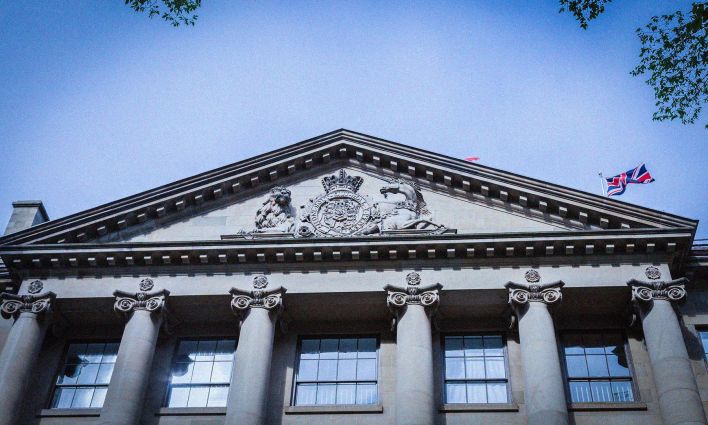The big-ticket item in the Nova Scotia budget is the two percent corporate tax cut (from 16%) at $70.5 million, plus a decrease in the small business tax (from 3% to 2.5%) at a cost of $10.5 million. These tax cuts will cost $81 million, but the Premier says he is “convinced that money would go back into the economy, spurring further growth.” This announcement was first made by Premier McNeil in his state of the union address, which was given at the Halifax Chamber of Commerce, a tradition that tells us a lot about who matters most to our government.
As senior economist David Macdonald recently reminded us: “Canada’s long running (and very expensive) experiment in corporate tax rates–to see if lowering them to compete with U.S. levels leads to extra investment in the economy–was more or less a failure. Companies used the differential to enrich themselves and their shareholders.” The federal corporate tax rates alone went from 28% in 2000 to 15%. As Macdonald shows, while these rates plummeted, payments to shareholders, through dividends or share buybacks, doubled as a share of GDP, while corporations hoarded cash. And, most of those who will be enriched are in corporations headquartered elsewhere.
Premier McNeil’s claim that these tax cuts will spur economic growth is the same old trickle-down economic theory we have heard for 30 years. Those at the bottom and even the middle are still waiting for their share in that growth. At a time when even the IMF is raising the alarm about growing income inequality, our government chooses to reward the same people at the top who have benefitted from decades of tax cuts. As the IMF points out, “increased inequality can erode social cohesion, lead to political polarization, and ultimately lower economic growth.”
What kind of society do we want?
Budget time is a time to ask, what kind of society do you want to live in? Do we want a society where everyone has access to the means and opportunity to fulfill their potential and participate as full and equal members? In contrast, our own province has all the markings of one that is not thriving for the many. Nova Scotia has the lowest median after-tax income in Canada in 2018, at $52,200 just over $9000 a year less than the Canadian average. Nova Scotia has the second highest poverty rate of all provinces at 15.9% (low income measure after tax, 2018). It is not surprising then that Nova Scotia also has highest rate of food insecurity (15.4%) for any province and the highest rate of severe food insecurity (4.6 percent of households).
What is the real cost of $80 million in tax cuts? Add to that the $55 million which the government is leaving on the table as a surplus. $135 million could have made a big difference to improve public services and income supports, while those who rely on governments as the last resort face trying to make ends meet with assistance that leaves them deep in poverty; Single people deemed employable receive 39% of the government income support needed to buy a basic basket of goods. Nothing in this budget will help them directly.
The government did increase support to families with children, by raising the threshold as well as increasing the amount of assistance provided in the Nova Scotia Child Benefit. This is a good thing since we know that there are 24.2% of children who live in poverty in Nova Scotia, or close to 1 in 4 children, which is the third-highest provincial rate in Canada and the highest in Atlantic Canada. However, the NS Child Benefit increase is paltry considering how deep the poverty is that families face. For example, a family with two children, which receives the most assistance, is still short by more than $10,000 a year to afford a basic basket of goods. The increase to the NSCB will mean about an extra $300 to $900 per family per year depending on how many children they have. Let’s also put this assistance into perspective—the entire budget for this benefit represents 0.37% of the total budget and the increase only cost $18 million.
Sprinkles of spending
While we can applaud the government for investing in the early years by expanding access to pre-primary, there are serious concerns about the continued lack of access to an integrated system of quality, affordable child care provided by qualified, well-compensated early childhood educators.
Should you want to increase your education, you already face the second-highest tuition fees in Canada, and they are only likely going up given that the post-secondary education sector saw no increase in this budget not even to cover inflationary pressures.
Providing a small amount to support nursing homes that are severely understaffed and underfunded, is insufficient.
Will this budget make it less of a crapshoot to get access to the health care you need in your community? Unlikely.
What about investing in the just transition to enable good green jobs in our province? A green new deal budget this is not.
As for dealing with the housing crisis, the lion’s share is going to rent subsidies for landlords. This is a band-aid solution at best, and at worst it exacerbates the housing situation by rewarding the very same people who are profiting off a housing market with a 1% vacancy rate (in Halifax). The capital budget should have included building non-profit, co-operative (non-market based) housing to address the social housing waitlist and to ensure there are permanent, affordable options that then increase the supply and dampen the market. There are reportedly 5,700 on the social housing waitlist. Policy by subsidy does not deal with supply; Subsidies do not create new affordable rental housing, just like they do not create new child care spaces.
Investing in our collective well-being
As a province, we can make different choices, but we require the revenue and political will to do so. This budget does not make up for many years of not properly funding the services and supports Nova Scotians need.
- On a per-capita basis, our government spends $11,177, which is less than they were spending in 2018-19 ($11,349)-with an increase in population, comes an increase in need. We are one of the lowest spenders per capita in the country.
- Nova Scotia’s proportional spending on debt interest payments has shrunk dramatically from a high of 19% in 2000 to a low of 7.5%.
- Moreover, Nova Scotia’s net debt to GDP peaked in 1999-000 at 47.1% and is projected to hold to just under 34%. We are in good fiscal health in this respect.






